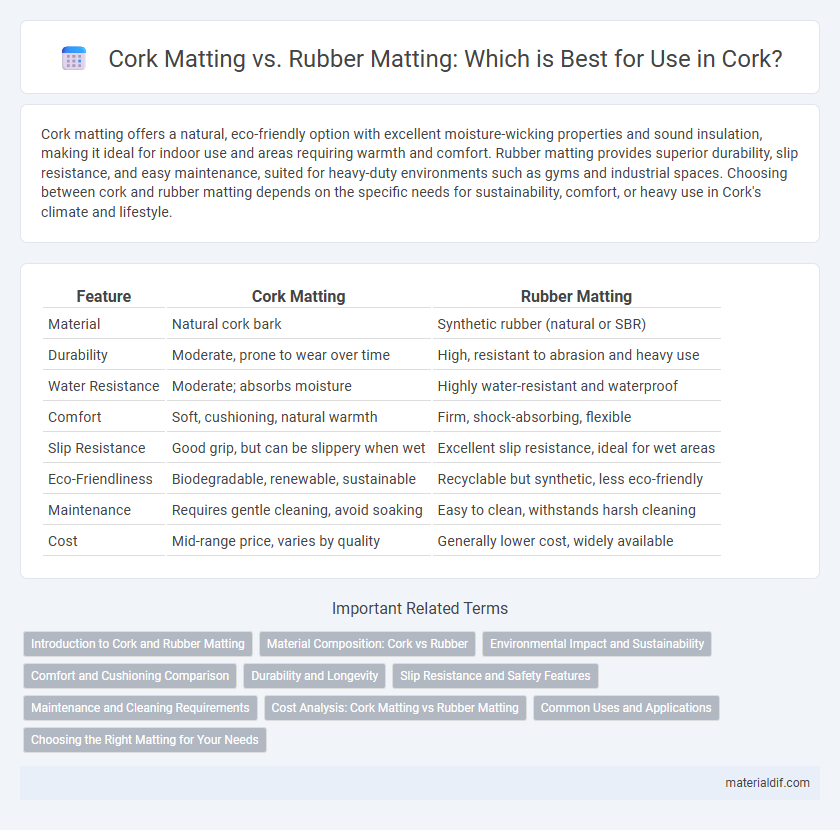Cork matting offers a natural, eco-friendly option with excellent moisture-wicking properties and sound insulation, making it ideal for indoor use and areas requiring warmth and comfort. Rubber matting provides superior durability, slip resistance, and easy maintenance, suited for heavy-duty environments such as gyms and industrial spaces. Choosing between cork and rubber matting depends on the specific needs for sustainability, comfort, or heavy use in Cork's climate and lifestyle.
Table of Comparison
| Feature | Cork Matting | Rubber Matting |
|---|---|---|
| Material | Natural cork bark | Synthetic rubber (natural or SBR) |
| Durability | Moderate, prone to wear over time | High, resistant to abrasion and heavy use |
| Water Resistance | Moderate; absorbs moisture | Highly water-resistant and waterproof |
| Comfort | Soft, cushioning, natural warmth | Firm, shock-absorbing, flexible |
| Slip Resistance | Good grip, but can be slippery when wet | Excellent slip resistance, ideal for wet areas |
| Eco-Friendliness | Biodegradable, renewable, sustainable | Recyclable but synthetic, less eco-friendly |
| Maintenance | Requires gentle cleaning, avoid soaking | Easy to clean, withstands harsh cleaning |
| Cost | Mid-range price, varies by quality | Generally lower cost, widely available |
Introduction to Cork and Rubber Matting
Cork matting, derived from the bark of the cork oak tree, offers natural insulation, moisture resistance, and a sustainable alternative for flooring and cushioning needs. Rubber matting, made from synthetic or recycled rubber, provides high durability, slip resistance, and excellent impact absorption, suitable for heavy-duty environments. Both materials serve distinct purposes, with cork emphasizing eco-friendliness and thermal comfort, while rubber prioritizes strength and industrial resilience.
Material Composition: Cork vs Rubber
Cork matting consists of natural bark harvested from cork oak trees, offering a renewable, biodegradable material rich in suberin, which provides water resistance and durability. Rubber matting is made primarily from either natural latex harvested from rubber trees or synthetic polymers like styrene-butadiene, delivering high elasticity, abrasion resistance, and chemical stability. Cork's cellular structure promotes breathability and insulation, whereas rubber's dense matrix excels in shock absorption and slip resistance, highlighting distinct benefits based on material composition.
Environmental Impact and Sustainability
Cork matting offers superior environmental benefits compared to rubber matting due to its renewable harvesting process that does not harm the cork oak tree, making it a highly sustainable option. In contrast, rubber matting often relies on synthetic materials or non-renewable sources, contributing to higher carbon emissions and landfill waste. Cork's natural biodegradability and low-energy production further enhance its eco-friendly profile, making it a preferred choice for environmentally conscious flooring solutions.
Comfort and Cushioning Comparison
Cork matting offers natural cushioning with excellent shock absorption due to its cellular structure, making it ideal for prolonged standing and ergonomic comfort. Rubber matting provides denser cushioning with greater resilience and durability, effectively reducing fatigue on hard floors but sometimes feeling firmer underfoot compared to cork. In workplace environments or homes prioritizing comfort, cork matting's blend of softness and thermal insulation often surpasses rubber for long-term comfort.
Durability and Longevity
Cork matting offers natural antimicrobial properties and moderate durability, making it suitable for low-traffic areas with minimal wear. Rubber matting excels in high durability and longevity due to its resistance to heavy impact, moisture, and abrasion, ideal for industrial and outdoor use. When comparing durability and longevity, rubber matting outperforms cork, especially in environments exposed to constant heavy use or harsh conditions.
Slip Resistance and Safety Features
Cork matting offers natural slip resistance due to its textured surface and moisture-wicking properties, making it ideal for dry, indoor environments. Rubber matting provides superior slip resistance in wet or oily conditions because of its non-porous, flexible composition, often featuring anti-slip treads or patterns for enhanced safety. Both materials contribute to safety, but rubber matting is generally preferred in industrial or high-traffic areas requiring maximum slip protection.
Maintenance and Cleaning Requirements
Cork matting requires gentle cleaning with a damp cloth and mild detergent, making it low-maintenance compared to rubber matting, which can be cleaned more aggressively using water and stronger cleaners due to its durable, non-porous surface. Cork's natural antimicrobial properties help reduce odor buildup but necessitate avoiding excessive moisture to prevent damage or warping. Rubber matting is ideal for high-traffic areas demanding frequent deep cleaning, whereas cork matting is better suited for environments where minimal upkeep and eco-friendliness are prioritized.
Cost Analysis: Cork Matting vs Rubber Matting
Cork matting generally offers a higher upfront cost compared to rubber matting, yet it provides excellent durability and natural insulation properties that can reduce long-term maintenance expenses. Rubber matting presents a more budget-friendly initial investment, with strong resistance to wear and tear, making it suitable for high-traffic areas with minimal upkeep. Evaluating the lifecycle cost reveals cork's eco-friendly benefits and comfort may offset its price premium over the more economical and resilient rubber option.
Common Uses and Applications
Cork matting is widely used in yoga studios, flooring, and insulation due to its natural cushioning, moisture resistance, and eco-friendly properties. Rubber matting excels in industrial environments, gyms, and playgrounds, providing superior durability, slip resistance, and impact absorption. Both materials are favored for their comfort and safety features, but cork prioritizes sustainability, while rubber emphasizes heavy-duty protection.
Choosing the Right Matting for Your Needs
Cork matting offers natural insulation, moisture resistance, and eco-friendly benefits, making it ideal for sustainable home and office use. Rubber matting provides superior durability, slip resistance, and cushioning, perfect for high-traffic or industrial areas where safety is a priority. Selecting between cork and rubber matting depends on factors like environment, usage intensity, maintenance needs, and desired aesthetic.
Cork matting vs Rubber matting Infographic

 materialdif.com
materialdif.com